
16-stamp pane that goes on sale June 2/USPS
They are a sweeping, majestic, gorgeous collection of images that skims the surface of the diversity of the National Park System. And they practically implore the U.S. Postal Service to continue promoting the parks long after the National Park Service Centennial passes.
Though just 16 stamps in this unique collection, the stamps showcase the park system's diversity with scenes from such parks as Gulf Islands National Seashore on the Mississippi-Florida border and Marsh-Billings-Rockefeller National Historical Park in Vermont to Bandelier National Monument in New Mexico and Haleakala National Park in Hawaii.
A unique pane of all 16 National Parks Forever stamps will have its first-day-of-issue ceremony on June 2 at New York City’s Jacob Javits Center at 11 a.m. as part of World Stamp Show-NY 2016, the world’s largest stamp show that takes place in the United States once a decade. Dedication ceremonies will also take place at or near each of the national parks associated with the stamps.

Matt Dieterich's time-lapse shot taken at Mount Rainier National Park.
Designing The National Parks Stamp Pane
The National Park System consists of more than 400 park sites. The stamp pane, designed by Ethel Kessler of Bethesda, Maryland, includes 16 stamp images featuring existing art or photography representing the regional diversity of the National Park System. All stamps show national parks or plants, animals, artwork, objects and structures found in or associated with a national park. Small type on the margin of each stamp indicates the park’s location.
Ms. Kessler arranged the stamps to approximate their locations around America: Alaska’s Glacier Bay National Park and Preserve on the upper left; Maine’s Acadia National Park on the upper right; Hawaii’s Haleakalā National Park on the bottom left; and Florida’s and Mississippi’s Gulf Islands National Seashore on the bottom right.
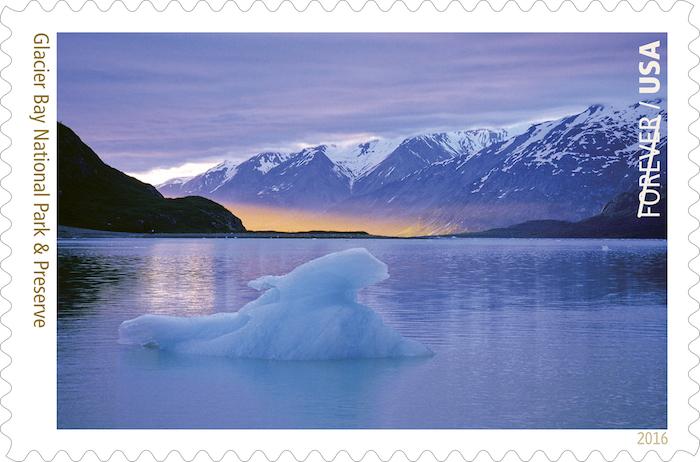
Glacier Bay National Park photo by Tom Bean.
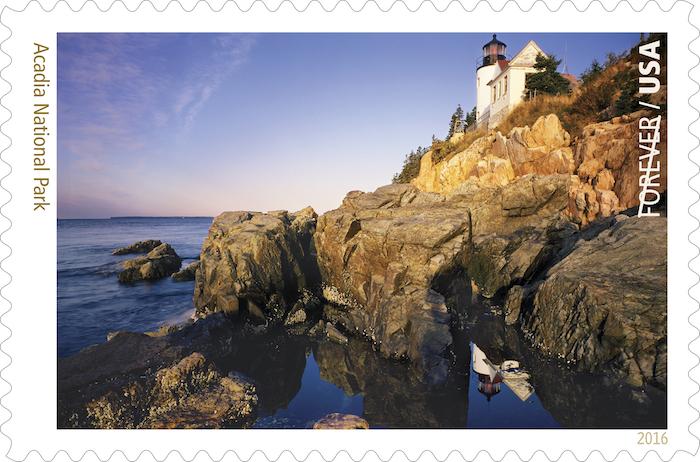
David Muench's photo of Bass Harbor Head Light at Acadia National Park.
Top Row
The top row includes four stamps. The first features a photograph by Tom Bean of Flagstaff, Arizona, of Glacier Bay National Park and Preserve in Alaska. The second features a photograph by Matt Dieterich of Pittsburgh, Pennsylvania, of Mount Rainier National Park in Washington State (see his time lapse video). The third shows a detail from the oil-on-canvas painting “Scenery in the Grand Tetons” by Albert Bierstadt (1830–1902), currently held at Marsh-Billings-Rockefeller National Historical Park in Vermont. The fourth is a photograph by David Muench of Goleta, California, of Bass Harbor Head Light at Acadia National Park in Maine.

Second Row
The second row from the top includes two stamps, one on either side of the central selvage image. The stamp on the left features a detail of a chromolithograph-on-canvas, “The Grand Canyon of Arizona, from Hermit Rim Road” by artist Thomas Moran (1837–1926) from the collection of Grand Canyon National Park in Arizona. The stamp on the right features a photograph by Tim Fitzharris of Fayetteville, Arkansas, of wild horses at Assateague Island National Seashore, located in Maryland and Virginia.
Third Row
The third row from the top includes four stamps, two on either side of the central selvage image. The first stamp on the left features a detail of a photograph by Tim Campbell of Balclutha, a ship at San Francisco Maritime National Historical Park. The second stamp on the left shows a photograph by Tom Till of Moab, Utah, taken at Arches National Park in Utah. The first stamp on the right features a photograph by QT Luong of San Jose, California, of Theodore Roosevelt National Park in North Dakota. In 2009, Ken Burns and Dayton Duncan featured Roosevelt in the film The National Parks: America’s Best Idea. The second stamp on the right shows a photograph by Cindy Dyer of Alexandria, Virginia, taken at Kenilworth Park & Aquatic Gardens in Washington, D.C.
The Grand Canyon of Arizona, from Hermit Rim Road [detail], Thomas Moran, Grand Canyon National Park, GRCA 134696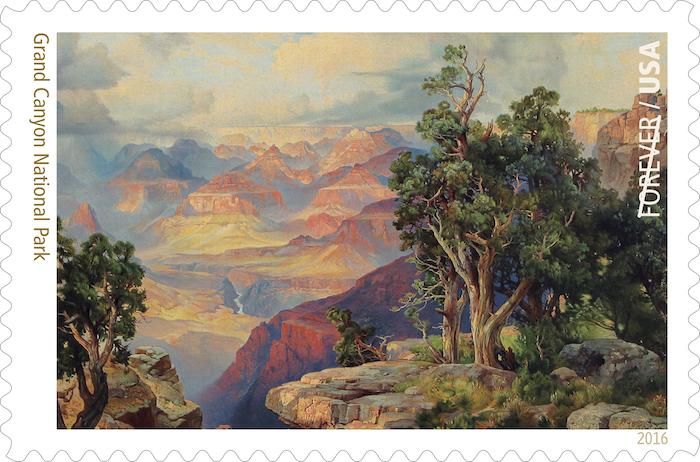
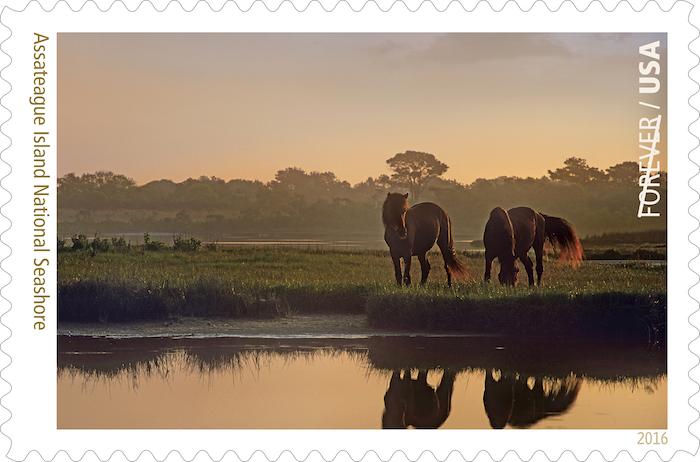
Wild horses at Assateague Island National Seashore by Tim Fitzharris.

Administration Building, Frijoles Canyon Helmuth Naumer, Sr. Bandelier National Monument, BAND 1409.

Tim Campbell's shot from San Francisco Maritime National Historical Park.
Fourth Row
The fourth row from the top includes two stamps, one on either side of the central selvage image. The stamp on the left features a 1935–1936 pastel-on-paper depiction by Helmuth Naumer, Sr. (1907–1990) of the Revival-style visitor center at Frijoles Canyon at Bandelier National Monument in New Mexico. The stamp on the right features a photograph by Paul Marcellini of Miami, Florida, of Everglades National Park in Florida.
Fifth Row
The fifth and bottom row of the pane includes four stamps. The first features a photograph by Kevin Ebi who lives near Seattle, Washington, of Haleakalā National Park in Hawaii. The second shows a photograph by Art Wolfe of Seattle, Washington, of bison at Yellowstone National Park, located in Idaho, Montana, and Wyoming. The third stamp shows a photograph by Richard McGuire of Carlsbad Caverns National Park in New Mexico. The fourth stamp features a photograph by John Funderburk of Hernando, Florida, of a heron at Gulf Islands National Seashore, located in Florida and Mississippi.
Center Image
The image in the center is a detail of artwork from the 1-cent Yosemite stamp issued in 1934, rendered here in light brown. Text superimposed over the center image reads: “Our national parks tell distinctly American stories. Whether they inspire you to marvel at grand vistas, travel along scenic waterways and winding paths, or visit historic buildings and homes, discovery and exploration await.” A banner across the top of the pane reads “NATIONAL PARKS.”
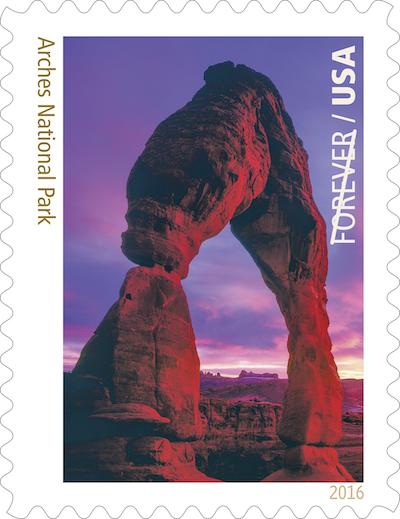
Tom Till's photo from Arches National Park.
Text on the back of the stamp pane (verso text)
In the 100 years since its creation in 1916, the National Park Service has been the steward of an ongoing story that every American continues to write.
Our first national park — as well as the world’s — was established with the creation of Yellowstone in 1872, and Americans have long envisioned parks as places of wild wonders and breathtaking views. Those “crown jewels” will always be iconic American landscapes, but our park system is now even more remarkable for its breadth. Parkways, monuments, seashores, scenic rivers, urban parks, recreation areas, historic buildings and homes — our park system encompasses all of these and more. Parks also offer American history on a human scale, interpreting and making accessible such complex events as the Civil War and the civil rights movement, and they preserve irreplaceable resources for future study and enjoyment, from ancient fossils and fragile ecosystems to an amazing array of artifacts and art.
Each year, millions of people seek out the more than 400 sites in the national park system, where they find endless opportunities for adventure, education, and fun. With the enthusiastic support of visitors, our parks will continue to delight and inspire all Americans and impart a profound legacy for generations to come.

QT Luong's photo from Theodore Roosevelt National Park.
Four of the images on these stamps were provided by the National Park Service and represent just a glimpse of their priceless holdings. The oil-on-canvas painting Scenery in the Grand Tetons by Albert Bierstadt (detail; first row, second from right) is in the collection of Marsh-Billings-Rockefeller National Historical Park. The chromolithograph-on-canvas Grand Canyon of Arizona, from Hermit Rim Road by Thomas Moran (detail; second row, left) is in the collection of Grand Canyon National Park. The three-masted, steel-hulled, square-rigged Balclutha (third row, first from left) is a familiar sight at San Francisco Maritime National Historical Park. The pastel-on-paper Administration Building, Frijoles Canyon (fourth row, left) by Helmuth Naumer Sr., is in the collection of Bandelier National Monument. The image at the center is a detail of the 1-cent Yosemite stamp issued in 1934, rendered here in light brown. The other images on these stamps are the work of independent photographers — evidence of the vast artistic inspiration our national parks can provide.

Cindy Dyer's photo from Kenilworth Park & Aquatic Gardens.

Kevin Ebi's photo from Haleakala National Park.

Art Wolfe's Yellowstone National Park photo.

Carlsbad Caverns National Park photo by Richard McGuire.

Everglades National Park photo by Paul Marcellini.

 Support Essential Coverage of Essential Places
Support Essential Coverage of Essential Places







Comments
I have visited 31 of 58 national parks, and hope to finish before I die! Thanks for this tribute to the BEST IDEA in the USA!
What a great tribute to the best of our best. As a nation we are fortunate to have such wonderful treasures...and we should treasure them. Happy 100th Birthday NPS.
I have visited all 59 National Parks and also all 411 units in the NP system
my tribute to America's Best Idea !!
These stamps are beautiful, and we'll be stocking up to use for years to come.